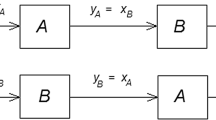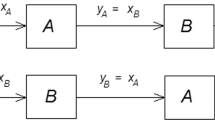Abstract
Decomposition is a common tool for the synthesis of many physical systems. It is also used for analyzing large-scale systems which are then known as tearing and reconstruction. On the other hand, commutativity of cascade-connected systems has gained a great deal of interest, and its possible benefits have been pointed out on the literature. In this paper, the necessary and sufficient conditions for decomposition of any third-order linear time-varying system as a commutative pair of first- and second-order systems of which parameters are also explicitly expressed, are investigated. Further, additional requirements in case of nonzero initial conditions are derived. This paper highlights the direct formulas for realization of any third-order linear time-varying systems as a series (cascade) connection of first- and second-order subsystems. This series connection is commutative so that it is independent from the sequence of subsystems in the connection. Hence, the convenient sequence can be decided by considering the overall performance of the system when the sensitivity, disturbance, and robustness effects are considered. Realization covers transient responses as well as steady-state responses.





Similar content being viewed by others
References
M. Arnoldy, N. Begunz, P. Gurevichx, E. Kwamey, H. Lamba, D. Rachinskii, Dynamics of discrete time systems with a hysteresis stop operator. SIAM J. Appl. Dyn. Syst. 16, 91–119 (2017)
W.N. Dale, M.C. Smith, Stabilizability and existence of system representations for discrete-time time-varying systems. SIAM J. Control Optim. 31, 1538–1557 (1993)
I. Dassios, Optimal solutions for non-consistent singular linear systems of fractional nabla difference equations. Circ. Syst. Signal Process. 34, 1769–1797 (2015)
I. Dassios, D. Baleanu, G. Kalogeropoulos, On non-homogeneous singular systems of fractional nabla difference equations. Appl. Math. Comput. 227, 112–131 (2014)
I. Gohberg, M.A. Kaashoek, A.C.M. Ran, Partial role and zero displacement by cascade connection. SIAM J. Matrix Anal. Appl. 10, 316–325 (1989)
C. Jaeger, T.N. Blalock, Microelectronic Circuit Design, 3rd edn. (McGraw-Hill, Boston, 2006)
M. Koksal, A Survey on the commutativity of time-varying systems, METU, Gaziantep Engineering Faculty, Technical Report no: GEEE CAS-85/1 (1985)
M. Koksal, An exhaustive study on the commutativity of time-varying systems. Int. J. Control 47, 1521–1537 (1988)
M. Koksal, Commutativity of second-order time-varying systems. Int. J. Control 36, 541–544 (1982)
M. Koksal, Corrections on ‘commutativity of second-order time-varying systems’. Int. J. Control 38, 273–274 (1983)
M. Koksal, General conditions for commutativity of time-varying systems, in Proceedings of the international conference on telecommunication and control, Halkidiki, Greece, pp. 223–225 (1984)
M.E. Koksal, Decomposition of a second-order linear time-varying differential system as the series connection of two first-order commutative pairs. Open Math. 14, 693–704 (2016)
M.E. Koksal, Inverse commutativity conditions for second-order linear time-varying systems. J. Math. 2017, 1–6 (2017)
M. Koksal, M.E. Koksal, Commutativity of cascade connected discrete time linear time-varying systems (in Turkish), in 2013 automatic control national meeting TOK”2013, Malatya-Turkey, pp. 1128–1131 (2013)
M. Koksal, M.E. Koksal, Commutativity of cascade connected discrete time linear time-varying systems. Trans. Inst. Meas. Control 37, 615–622 (2015)
M. Koksal, M.E. Koksal, Commutativity of linear time-varying differential systems with non-zero initial conditions: a review and some new extensions. Math. Probl. Eng. 2011, 1–25 (2011)
H.A. Levine, Y.J. Seo, Discrete dynamical systems in multiple target and alternate SELEX. SIAM J. Appl. Dyn. Syst. 14, 1048–1101 (2015)
R.G. Lyons, Understanding Digital Signal Processing, 3rd edn. (Prentice Hall, Englewood Cliffs, 2011)
E. Marshal, Commutativity of time varying systems. Electron. Lett. 13, 539–540 (1977)
H.N. Nguyen, S. Olaru, P.O. Gutman, M. Hovd, Constrained control of uncertain, time-varying linear discrete-time systems subject to bounded disturbances. IEEE Trans. Autom. Control 60, 831–836 (2015)
K. Ninomiya, K. Harada, I. Miyazaki, Stability analysis of an active filter using cascade connection of switching regulators. Electron. Commun. Jpn. Part I Commun. 80, 87–94 (1997)
A.V. Oppenheim, R.W. Schafer, Discrete-Time Signal Processing (Prentice-Hall, Engle-wood Cliffs, 1989), p. 406
B. Rahman, K.B. Blyuss, Y.N. Kyrychko, Dynamics of neural systems with discrete and distributed time delays. SIAM J. Appl. Dyn. Syst. 14, 2069–2095 (2015)
S.V. Salehi, Comments on ‘commutativity of second-order time-varying systems’. Int. J. Control 37, 1195–1196 (1983)
W.J. Shi, Y. Yao, T.Q. Zhang, X.J. Meng, A method of recognizing biology surface spectrum using cascade-connection artificial neural nets. Spectrosc. Spectr. Anal. 28, 983–987 (2008)
D. Vasileska, S.M. Goodnick, Computational Electronics (Morgan & Claypool Publishers, San Rafael, 2006)
F. Wirth, Dynamics of time-varying discrete-time linear systems: spectral theory and the protected system. SIAM J. Control Optim. 36, 447–487 (1998)
J.M. Zhang, W.F. Qi, T. Tian, W.X. Wang, Further results on the decomposition of an NFSR into the cascade connection of an NFSR Into an LFSR. IEEE Trans. Inf. Theory 61, 645–654 (2015)
Acknowledgements
The first author was supported by the Scientific and Technological Research Council of Turkey under the Project 115E952.
Author information
Authors and Affiliations
Corresponding author
Additional information
Publisher's Note
Springer Nature remains neutral with regard to jurisdictional claims in published maps and institutional affiliations.
Rights and permissions
About this article
Cite this article
Koksal, M.E., Yakar, A. Decomposition of Third-Order Linear Time-Varying Systems into Its Second- and First-Order Commutative Pairs. Circuits Syst Signal Process 38, 4446–4464 (2019). https://doi.org/10.1007/s00034-019-01075-4
Received:
Revised:
Accepted:
Published:
Issue Date:
DOI: https://doi.org/10.1007/s00034-019-01075-4




